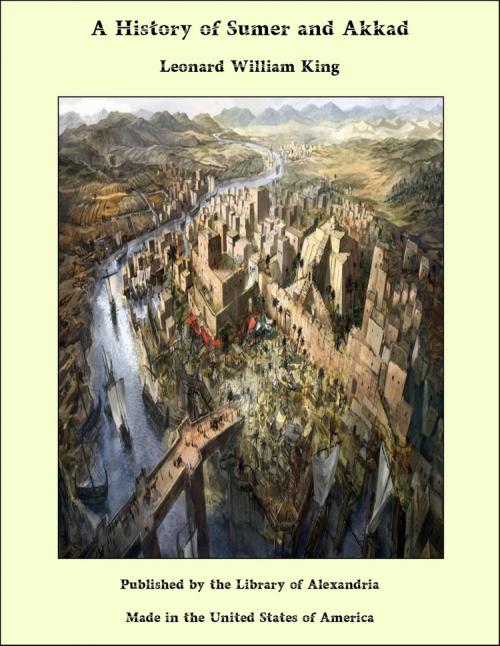A History of Sumer and Akkad
Nonfiction, Religion & Spirituality, New Age, History, Fiction & Literature| Author: | Leonard William King | ISBN: | 9781465618818 |
| Publisher: | Library of Alexandria | Publication: | March 8, 2015 |
| Imprint: | Language: | English |
| Author: | Leonard William King |
| ISBN: | 9781465618818 |
| Publisher: | Library of Alexandria |
| Publication: | March 8, 2015 |
| Imprint: | |
| Language: | English |
The study of origins may undoubtedly be regarded as the most striking characteristic of recent archaeological research. There is a peculiar fascination in tracking any highly developed civilization to its source, and in watching its growth from the rude and tentative efforts of a primitive people to the more elaborate achievements of a later day. And it is owing to recent excavation that we are now in a position to elucidate the early history of the three principal civilizations of the ancient world. The origins of Greek civilization may now be traced beyond the Mycenean epoch, through the different stages of Aegean culture back into the Neolithic age. In Egypt, excavations have not only yielded remains of the early dynastic kings who lived before the pyramid-builders, but they have revealed the existence of Neolithic Egyptians dating from a period long anterior to the earliest written records that have been recovered. Finally, excavations in Babylonia have enabled us to trace the civilization of Assyria and Babylon back to an earlier and more primitive race, which in the remote past occupied the lower plains of the Tigris and Euphrates; while the more recent digging in Persia and Turkestan has thrown light upon other primitive inhabitants of Western Asia, and has raised problems with regard to their cultural connections with the West which were undreamed of a few years ago. It will thus be noted that recent excavation and research have furnished the archaeologist with material by means of which he may trace back the history of culture to the Neolithic period, both in the region of the Mediterranean and along the valley of the Nile. That the same achievement cannot be placed to the credit of the excavator of Babylonian sites is not entirely due to defects in the scope or method of his work, but may largely be traced to the character of the country in which the excavations have been carried out. Babylonia is an alluvial country, subject to constant inundation, and the remains and settlements of the Neolithic period were doubtless in many places swept away, and all trace of them destroyed by natural causes. With the advent of the Sumerians began the practice of building cities upon artificial mounds, which preserved the structure of the buildings against flood, and rendered them easier of defence against a foe. It is through excavation in these mounds that the earliest remains of the Sumerians have been recovered; but the still earlier traces of Neolithic times, which at some period may have existed on those very sites, must often have been removed by flood before the mounds were built. The Neolithic and pre-historic remains discovered during the French excavations in the graves of Mussian and at Susa, and by the Pumpelly expedition in the two Kurgans near Anau, do not find their equivalents in the mounds of Babylonia so far as these have yet been examined.
The study of origins may undoubtedly be regarded as the most striking characteristic of recent archaeological research. There is a peculiar fascination in tracking any highly developed civilization to its source, and in watching its growth from the rude and tentative efforts of a primitive people to the more elaborate achievements of a later day. And it is owing to recent excavation that we are now in a position to elucidate the early history of the three principal civilizations of the ancient world. The origins of Greek civilization may now be traced beyond the Mycenean epoch, through the different stages of Aegean culture back into the Neolithic age. In Egypt, excavations have not only yielded remains of the early dynastic kings who lived before the pyramid-builders, but they have revealed the existence of Neolithic Egyptians dating from a period long anterior to the earliest written records that have been recovered. Finally, excavations in Babylonia have enabled us to trace the civilization of Assyria and Babylon back to an earlier and more primitive race, which in the remote past occupied the lower plains of the Tigris and Euphrates; while the more recent digging in Persia and Turkestan has thrown light upon other primitive inhabitants of Western Asia, and has raised problems with regard to their cultural connections with the West which were undreamed of a few years ago. It will thus be noted that recent excavation and research have furnished the archaeologist with material by means of which he may trace back the history of culture to the Neolithic period, both in the region of the Mediterranean and along the valley of the Nile. That the same achievement cannot be placed to the credit of the excavator of Babylonian sites is not entirely due to defects in the scope or method of his work, but may largely be traced to the character of the country in which the excavations have been carried out. Babylonia is an alluvial country, subject to constant inundation, and the remains and settlements of the Neolithic period were doubtless in many places swept away, and all trace of them destroyed by natural causes. With the advent of the Sumerians began the practice of building cities upon artificial mounds, which preserved the structure of the buildings against flood, and rendered them easier of defence against a foe. It is through excavation in these mounds that the earliest remains of the Sumerians have been recovered; but the still earlier traces of Neolithic times, which at some period may have existed on those very sites, must often have been removed by flood before the mounds were built. The Neolithic and pre-historic remains discovered during the French excavations in the graves of Mussian and at Susa, and by the Pumpelly expedition in the two Kurgans near Anau, do not find their equivalents in the mounds of Babylonia so far as these have yet been examined.















